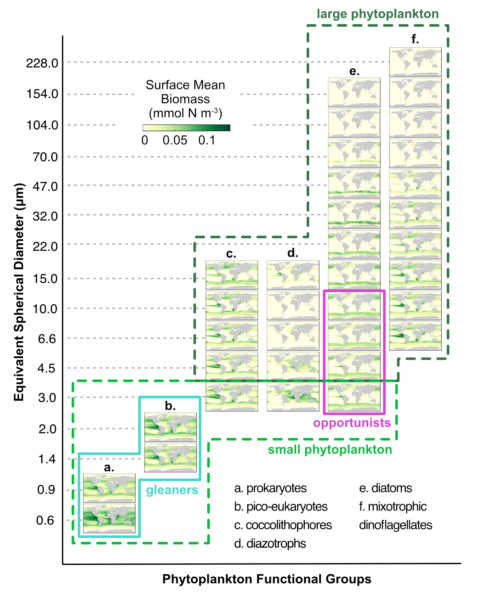MITgcm 3-daily global sea surface temperature, ocean currents, nitrate and phytoplankton biomass (1992 - 2016)
MITgcm 3-daily global sea surface temperature, ocean currents, nitrate and phytoplankton biomass (1992 - 2016)
About this collection
- Extent
-
1 digital object.
- Cite This Work
-
Jahn, Oliver; Hill, Christopher; Dutkiewicz, Stephanie; Follows, Michael (2019). MITgcm 3-daily global sea surface temperature, ocean currents, nitrate and phytoplankton biomass (1992 - 2016). UC San Diego Library Digital Collections. https://doi.org/10.6075/J0BR8QJ1
- Description
-
3-daily averaged sea surface temperature, ocean currents (u, v), nitrate and phytoplankton biomass for the 35 types in the top 10m of the model. Model output has been interpolated from the natural grid onto 1/5th degree resolution. This version of the model was run with the gud package (git://gud.mit.edu/gud1). The ecosystem model is based on Dutkiewicz et al (2015, 2019) and resolves the cycling of carbon, phosphorus, nitrogen silica, iron, and oxygen through inorganic, living, dissolved and particulate organic phases (including CDOM). The biogeochemical and biological tracers are transported and mixed by the MIT general circulation model (MITgcm, Marshall et al., 1997). The three dimensional configuration used here has nominally 18km horizontal resolution and 50 levels ranging from 10m in the surface to 500m at depth (the ECCO2 CS510 physical simulation, Menemenlis et al 2008). The model resolves 35 phytoplankton types, covering several functional groups (picophytoplankton, coccolithophores, diazotrophs, diatoms, mixotrophic dinoflagellates), 16 size classes (from 0.6 to 228um equivalent spherical diameter). There are 16 grazer size classes from 6.6 to 2280um equivalent spherical diameter. The phytoplankton types differ in the types of nutrients they require (e.g. diatoms require silica), maximum growth rate, nutrient half saturation constants, sinking rates, and palatability to grazers. Plankton growth, grazing and sinking parameters are linked to size following the allometric scaling used in Dutkiewicz et al (2019).
- Scope And Content
-
For additional information about the data, contact Stephanie Dutkiewicz (stephd@mit.edu). For information about the paper, contact Angela Kuhn (akuhncordova@ucsd.edu).
- Creation Date
- May 2016
- Date Issued
- 2019
- Creators
- Funding
-
NASA grant 80NSSC17K0561 (S. Dutkiewicz and O. Jahn)
- Geographics
- Topics
Formats
View formats within this collection
- Language
- No linguistic content; Not applicable
- Identifier
-
Identifier: Oliver Jahn: https://orcid.org/0000-0002-0130-5186
Identifier: Stephanie Dutkiewicz: https://orcid.org/0000-0002-0380-9679
- Related Resources
- Kuhn, A. M., Dutkiewicz, S., Jahn, O., Clayton, S., Rynearson, T. A., Mazloff, M. R., & Barton, A. D. (2019). Temporal and spatial scales of correlation in marine phytoplankton communities. Journal of Geophysical Research: Oceans, 124, 9417– 9438. https://doi.org/10.1029/2019JC015331
- Darwin Project Dataverse / Harvard University Dataverse / Harvard University: https://dataverse.harvard.edu/dataverse/GUD_CS510
- Dataset Darwin v0.2 cs510 / Engaging OpenDAP / Massachusetts Institute of Technology: https://engaging-opendap.mit.edu:8080/las/UI.vm
- Jahn, Oliver; Hill, Christopher, N.; Dutkiewicz, Stephanie; Follows, Michael, J., 2019, "3-daily surface (0-10m) phytoplankton biomass for Year 2000", Harvard Dataverse, V1. https://doi.org/10.7910/DVN/1HGIV8
- Dutkiewicz, S., A.E. Hickman, O. Jahn, W.W. Watson, C. Mouw, and M.J. Follows, 2015: Capturing optically important constituents and properties in a marine biogeochemical and ecosystem model. Biogeoscience, 12, 4447-4481. https://doi.org/10.5194/bg-12-4447-2015
- Dutkiewicz, S., Cermeno, P., Jahn, O., Follows, M. J., Hickman, A. E., Taniguchi, D. A. A., and Ward, B. A., 2020: Dimensions of marine phytoplankton diversity, Biogeosciences, 17, 609–634. https://doi.org/10.5194/bg-17-609-2020
- Marshall, J., Adcroft, A., Hill, C. N., Perelman, L., and Heisey, C, 1997: A finite-volume, incompressible Navier–Stokes model for studies of the ocean on parallel computers. J. Geophys. Res., 102, 5753–5766. https://doi.org/10.1029/96JC02775
- Menemenlis, D., Campin, J.-M., Heimbach, P., Hill, C., Lee, T., Nguyen, A., et al. (2008). ECCO2: High resolution global ocean and sea ice data synthesis. Mercator Ocean Quarterly Newsletter, (31), 13–21. https://www.mercator-ocean.fr/wp-content/uploads/2015/06/lettre_31_en.pdf
- Benoiston, A.-S., F.M. Ibarbalz, L. Bittner, L. Guidi, O. Jahn, S. Dutkiewicz and C. Bowler (2017) The evolution of diatoms and their biogeochemical functions. Philosophical Transcations of the Royal Society B, 372: 20160397. https://doi.org/10.1098/rstb.2016.0397
- McParland, EL and NM Levine (2018), The role of differential DMSP production and community composition in predicting variability of global surface DMSP concentrations, Limnology and Oceanography. https://doi.org/10.1002/lno.11076
- Tréguer, P., C. Bowler, B. Moriceau, S. Dutkiewicz, M. Gehlen, K. Leblanc, O. Aumont, L. Bittner, R. Dugdale, Z. Finkel, D. Iudicone, O. Jahn, L. Guidi, M. Lasbleiz, M. Levy, and P. Pondaven (2017) Influence of diatoms on the ocean biological pump. Nature Geoscience. https://doi.org/10.1038/s41561-017-0028-x
Primary associated publication
Related data
Described by
Referenced by
 Library Digital Collections
Library Digital Collections
